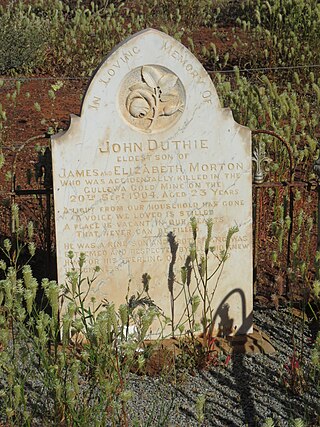Related Research Articles

Underground hard-rock mining refers to various underground mining techniques used to excavate "hard" minerals, usually those containing metals, such as ore containing gold, silver, iron, copper, zinc, nickel, tin, and lead. It also involves the same techniques used to excavate ores of gems, such as diamonds and rubies. Soft-rock mining refers to the excavation of softer minerals, such as salt, coal, and oil sands.
A mining accident is an accident that occurs during the process of mining minerals or metals. Thousands of miners die from mining accidents each year, especially from underground coal mining, although accidents also occur in hard rock mining. Coal mining is considered much more hazardous than hard rock mining due to flat-lying rock strata, generally incompetent rock, the presence of methane gas, and coal dust. Most of the deaths these days occur in developing countries, and rural parts of developed countries where safety measures are not practiced as fully. A mining disaster is an incident where there are five or more fatalities.

The TauTona Mine, formerly Western Deep Levels No.3 Shaft, is a gold mine located in the West Wits gold field west of Johannesburg. The mine is near the town of Carletonville in South Africa. At approximately 3.9 kilometers (2.4 mi) deep, it is home to the world's second deepest mining operation, rivalled only by the Mponeng Gold Mine, formerly Western Deep Levels No.1 Shaft. TauTona was temporarily closed in 2018.
The following lists events that happened during 1995 in South Africa.

Harmony Gold is the largest gold mining company in South Africa. Harmony operates in South Africa and in Papua New Guinea. The company has nine underground mines, one open-pit mine and several surface operations in South Africa. In Papua New Guinea, it has Hidden Valley, an open-pit gold and silver mine and a 50% interest in the Morobe Mining Joint Venture, which includes the Wafi-Golpu project and extensive exploration tenements. Outside the joint venture, Harmony's own exploration portfolio focuses principally on highly prospective areas in Papua New Guinea.

The Farmington Mine disaster was an explosion that happened at approximately 5:30 a.m. on November 20, 1968, at the Consol No. 9 coal mine north of Farmington and Mannington, West Virginia, United States.

The Lofthouse Colliery disaster was a mining accident in Lofthouse, in the West Riding of Yorkshire, England, on Wednesday 21 March 1973, in which seven mine workers died when workings flooded.

The 2008 Ukrainian coal mine collapse occurred at the Karl Marx Coal Mine in the city of Yenakiieve, Donetsk Oblast (province) of eastern Ukraine on June 8, 2008. The mine collapse was said to have been caused by a gas pipe explosion. The explosion occurred at a depth of about 1,750 feet (533 m). 37 miners were trapped underground at the time of the collapse, located 3,301 feet (1,006 m) below the surface of the earth. Additionally, five surface workers suffered from burns and other injuries in a blast that they described as one of the most powerful in the industry.

The Twin Shaft disaster occurred in the Newton Coal Company's Twin Shaft Colliery in Pittston, Pennsylvania, United States, on June 28, 1896, when a massive cave-in killed fifty-eight miners.

The 2009 Harmony Gold mine deaths occurred in late May and early June 2009 in Free State province, South Africa. At least 82 miners, many from Lesotho, Mozambique and Zimbabwe, died from inhalation of poisonous gasses created by a May 18 fire in the mineshaft.
The Central Norseman gold mine is located at Norseman, Western Australia. Norseman lies at the southern end of the Norseman-Wiluna Greenstone Belt, in the Eastern Goldfields Province of the Yilgarn Block, Western Australia.

Impala Platinum Holdings Limited or Implats is a South African holding company that owns several companies which operate mines that produce platinum and platinum group metals, as well as nickel, copper and cobalt. Its most significant mine is the Impala mine in the North West province of South Africa. The company also owns or has interest in the Two Rivers mine and the Marula mine in the South Africa Bushveld Igneous Complex and the Mimosa mine and Zimplats in Zimbabwe, as well as the Impala Refining Services which smelts and refines metals for other companies. In December 2019, Impala Canada was formed, owned by the holding company, out of the acquisition of North American Palladium and its mine in Ontario, Canada.

Fatality statistics in the Western Australian mining industry captures the number of people killed in the industry in the Australian state of Western Australia. During the period 2000-2012 (inclusive), a total of 52 fatalities occurred. In 2006, the Chamber of Minerals and Energy of Western Australia commissioned a taxonomic study to analyse the 306 mining fatalities which occurred between 1970 and 2006. The Department of Mines and Petroleum, later renamed the Department of Mines, Industry Regulation and Safety, the governing authority for the industry in the state, has published statistics for fatalities in mining dating back to 1943 and intends to publish statistics dating back to 1886, though early records are not expected to be exhaustive.
Vaal Reefs is a gold bearing reef which is mined near the town of Orkney in Dr Kenneth Kaunda District Municipality in the North West province of South Africa.
The Coalbrook mining disaster is the worst mining accident in the history of South Africa. The disaster occurred in the Coalbrook coal mine of Clydesdale Colliery on 21 January 1960 at around 19:00 when approximately 900 pillars caved in, almost 180 metres (590 ft) underground. The mine is situated in the Northern Free State, 21 kilometres (13 mi) south west of Vereeniging. About 1,000 miners were in the mine at the time and 437 died after being trapped, while the rest escaped through an incline shaft. The miners were suffocated by methane gas and crushed to death by rockfall.

Bentley Colliery was a coal mine in Bentley, near Doncaster in South Yorkshire, England, that operated between 1906 and 1993. In common with many other mines, it suffered disasters and accidents. The worst Bentley disaster was in 1931 when 45 miners were killed after a gas explosion. The site of the mine has been converted into a woodland.
The Kinross mine disaster resulted in the deaths of 177 miners and the injury of 235 others, making it one of the largest mining incidents in South Africa.
An elevator accident occurred on 27 November 2023 at the Impala Platinum mine in Rustenburg, South Africa, when an ascending mine elevator fell 200 m down the number 11 shaft. Thirteen miners were killed, 11 on the scene and two dying in hospital later, and 73 were injured. The elevator was stopped from falling further by its impacting with a platform within the shaft, resulting in a sudden stop which led to the fatalities.
References
- 1 2 "As Many As 100 Feared Dead in Gold Mine Accident". Associated Press. 11 May 1995. Archived from the original on 26 April 2019. Retrieved 26 April 2019.
- ↑ "We Care and we Remember Vaal Reefs, 10 May 1995". Minerals Council South Africa. Archived from the original on 26 April 2019. Retrieved 26 April 2019.
- 1 2 3 "Vaal Reefs Tragedy Commemorated". Mining Weekly. 10 May 2005. Archived from the original on 4 March 2016.
- ↑ "Locomotive crushes 105 gold miners". The Independent. 12 May 1995. Archived from the original on 3 September 2014. Retrieved 7 June 2023.
- 1 2 Drogin, Bob (12 May 1995). "S. African Mine Tragedy Kills 100 : Disaster: Underground train jumps tracks and plunges down shaft, crushing crowded elevator". Los Angeles Times. Archived from the original on 7 June 2023. Retrieved 7 June 2023.
- ↑ "Mine disaster pushes safety to top of political agenda". Mail & Guardian. 12 May 1995. Archived from the original on 14 June 2023. Retrieved 7 June 2023.
- ↑ "South Africa: Orkney: Gold Mine Accident 56 Bodies Recovered". AP. 12 May 1995. Archived from the original on 14 June 2023. Retrieved 8 June 2023.
- ↑ "Legends but no medals for mine rescuers". News24. 31 August 2000. Archived from the original on 12 June 2023. Retrieved 12 June 2023.
- ↑ "S.Africa - Vaal Reefs Mining Disaster Mass Funeral". AP Archive. 11 June 1995. Archived from the original on 11 June 2023. Retrieved 11 June 2023.
- 1 2 3 Plimmer, Fleur (1997). "Healing An industry: The Mine Health And Safety Act". Indicator SA. 14 (1).
- ↑ Mawson, Nicola (10 May 2005). "Vaal Reefs tragedy commemorated". Creamer Media's Engineering News.[ dead link ]
- ↑ Seymour, Chris (August 2005). "Mining Disasters - What lessons can be learnt". Archived from the original on 12 June 2023. Retrieved 12 June 2023.
- ↑ Wainwright, Dr. K A (December 2000). "Risk assessment of hoisting with and without a safety detaching hook" (PDF). Safety in Mines Research Advisory Committee. Archived (PDF) from the original on 26 October 2022. Retrieved 7 June 2023.
- ↑ Mendoza, Jean (23 January 2023). "The Truth about the Deadly Vaal Reefs Tragedy". Grunge. Archived from the original on 7 June 2023. Retrieved 7 June 2023.
- ↑ Barry, Brendan (May 1995). "Shifting the balance. The Leon Commission of Enquiry into health and safety in the mining industry" (PDF). Archived (PDF) from the original on 13 June 2023. Retrieved 13 June 2023.
- ↑ "Executive Summary of the Review of Mine Health and Safety, Post-Leon Commission" (PDF). 2003. Archived (PDF) from the original on 14 July 2022. Retrieved 13 June 2023.
- ↑ "NUM commemorates 27th year of The Vaal Reef disaster, 104 workers lost their lives". Polity. 10 May 2022. Archived from the original on 12 June 2023. Retrieved 12 June 2023.
- ↑ "About Vaal Reefs Disaster Trust". Archived from the original on 27 June 2012.
- ↑ Maree, Hein (30 April 2010). "Developing a Systemic Disaster Prevention Paradigm" (PDF). UCT. Archived (PDF) from the original on 11 June 2023. Retrieved 11 June 2023.
- ↑ Department of Mineral and Energy Affairs (1981). Report on the Circumstances Attending the Accident in No. 2 Shaft, Vaal Reefs Exploration and Mining Company Limited, in the Magisterial District of Klerksdorp, on 27 March 1980, which Caused the Death of 3 White and 28 Black Persons. G.M.E. report. Government Printer, South Africa. Archived from the original on 11 June 2023. Retrieved 11 June 2023.
- ↑ "Mine Disaster Toll Could be 62". Associated Press. 2 September 1987. Archived from the original on 26 April 2019. Retrieved 26 April 2019.
- ↑ "We Care and We Remember: St Helena, 31 August 1987". Minerals Council South Africa. Archived from the original on 26 April 2019. Retrieved 26 April 2019.